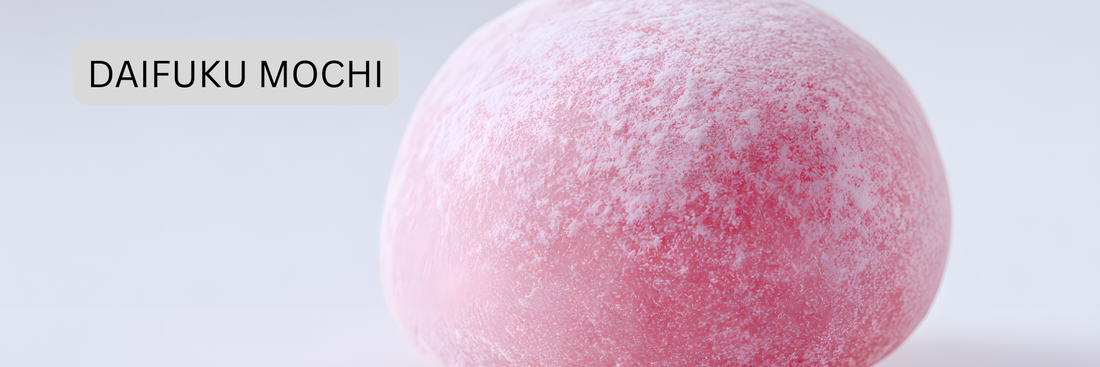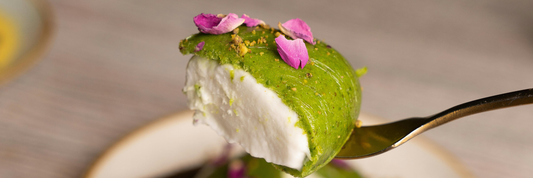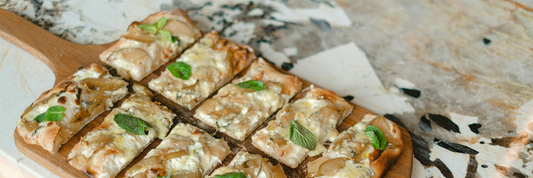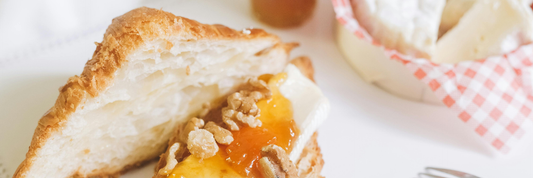Few desserts capture the heart of Japan’s culinary tradition quite like Daifuku Mochi. Soft, chewy, and delicately sweet, this classic treat has transcended borders to become one of the world’s most recognized symbols of Japanese confectionery.
In this guide, we’ll explore everything you need to know about Daifuku Mochi from its origins and cultural symbolism to its modern-day variations and how you can make it at home.
- Warabi Mochi: Japan’s Delicate Jelly Dessert You Must Try
- Types of Mochi: Complete Guide to Japanese Mochi Varieties
- Kinako Mochi: How to Make This Traditional Japanese Sweet at Home
What Is Daifuku Mochi?

Daifuku Mochi (大福餅), often shortened to Daifuku, is a traditional Japanese sweet (wagashi) made from soft glutinous rice dough (mochi) filled with a sweet paste, usually red bean paste (anko).
The word “Daifuku” translates to “great fortune” or “great luck,” which is why it’s often enjoyed during celebrations and holidays.
Main Characteristics:
- Soft, stretchy outer layer made from glutinous rice flour (mochiko or shiratamako)
- Sweet filling most commonly red bean paste, but sometimes white bean, fruit, or ice cream
- Lightly coated with cornstarch or potato starch to prevent sticking
The History and Origins of Daifuku Mochi

From “Harabuto Mochi” to “Daifuku”
The story of Daifuku Mochi dates back to the Edo period (1603–1868). Originally known as Harabuto Mochi (“belly-thick rice cake”), it was a simple rice cake with a small amount of sweet bean filling. Over time, the filling grew more generous — symbolizing abundance and happiness — and the name changed to Daifuku Mochi, meaning “great luck rice cake.”
Cultural Significance in Japan
Daifuku is not just a dessert; it’s a symbol of prosperity, good fortune, and happiness. It’s traditionally served during:
- New Year celebrations (Oshogatsu)
- Tea ceremonies
- Seasonal festivals
- Gift-giving occasions (Omiyage)
Modern Adaptations Worldwide
As Japan’s food culture spread globally, Daifuku evolved into international favorites such as mochi ice cream, fruit daifuku, and matcha-flavored varieties blending Japanese tradition with global taste preferences.
Mochi Ice Cream: History, Recipes, Flavors & Everything You Need to Know
Ingredients of Daifuku Mochi

Mochi Dough Base
The chewy mochi layer is made from:
- Glutinous rice flour (mochiko) or sweet rice flour (shiratamako)
- Sugar
- Water
When cooked and kneaded, it transforms into a smooth, elastic dough with the signature chewiness that defines mochi.
Common Fillings
- Anko (Red Bean Paste) – the most traditional filling, made from adzuki beans.
Koshian: smooth, sieved red bean paste
Tsubuan: coarse red bean paste with bean texture - Shiroan (White Bean Paste) – mild and sweet, often used with matcha or fruit.
- Fruit Fillings – strawberries (Ichigo Daifuku), mango, or kiwi for a refreshing twist.
- Ice Cream Fillings – popularized by brands like Yukimi Daifuku, combining cold ice cream inside chewy mochi.
- Matcha or Chocolate Fillings – modern fusions for global palates.
Coating Powders
- Cornstarch or potato starch: prevents sticking.
- Kinako (roasted soybean powder): adds nutty aroma.
- Icing sugar: for a sweeter touch.
Popular Types of Daifuku Mochi

There are dozens of Daifuku variations, each with its own unique flavor and regional identity.
Anko Daifuku
The most classic — soft mochi filled with smooth or chunky sweet red bean paste.
Ichigo Daifuku (Strawberry Daifuku)
A fresh strawberry wrapped with red bean paste and mochi. This variety became popular in the 1980s and is now one of Japan’s most iconic sweets.
Yomogi Daifuku
Made with yomogi (Japanese mugwort), giving the mochi a natural green color and herbal aroma.
Mame Daifuku
Contains whole adzuki beans or soybeans in the mochi dough, adding texture and flavor depth.
Shiroan Daifuku
Features a pale white bean paste for a more delicate sweetness.
Yukimi Daifuku (Mochi Ice Cream)
A modern invention — chewy mochi wrapped around ice cream, sold globally.
Matcha Daifuku
Combines matcha-flavored dough or filling with traditional bean paste loved for its earthy, bitter-sweet balance.
How to Make Daifuku Mochi at Home

Making Daifuku at home is simple once you master the timing and texture of mochi dough.
Ingredients:
- 100g glutinous rice flour (mochiko or shiratamako)
- 150ml water
- 50g sugar
- Sweet bean paste or fruit for filling
- Cornstarch for dusting
Steps:
- Mix & Microwave: Combine flour, sugar, and water. Microwave for 2–3 minutes, stirring halfway until thick and sticky.
- Knead the Dough: Dust your surface with starch and knead until smooth.
- Shape & Fill: Flatten small circles, place bean paste in the center, and wrap carefully.
- Dust & Serve: Roll lightly in starch to prevent sticking.
Tips for Perfect Mochi:
- Don’t overcook — it’ll harden quickly.
- Work while warm for smooth sealing.
- Store in an airtight container at room temperature (1–2 days).
Is Mochi Healthy? – A Complete Health Analysis
Daifuku Mochi vs. Other Japanese Sweets
| Feature | Daifuku Mochi | Mochi | Wagashi |
|---|---|---|---|
| Definition | Filled mochi with sweet paste | Plain rice cake | Traditional confectionery |
| Texture | Soft, chewy, filled | Chewy, plain | Varies (jelly, cake, bean paste) |
| Occasion | Festive dessert | Everyday snack | Ceremonial or seasonal sweet |
| Example | Ichigo Daifuku | Plain Mochi | Nerikiri, Manju |
Daifuku Mochi sits at the intersection of comfort food and art, offering both visual beauty and cultural meaning.
Modern Popularity and Global Spread

Daifuku in Japan
You can find Daifuku in nearly every Japanese convenience store, from Lawson to 7-Eleven, and in traditional sweet shops (wagashiya).
Global Variations
- United States & Canada: Mochi ice cream with flavors like matcha, mango, chocolate, and strawberry.
- Southeast Asia: Localized versions with tropical fruits like durian or coconut.
- Europe: Gourmet mochi cafés offering minimalist Japanese-style desserts.
Commercial Daifuku Brands
- Yukimi Daifuku (Lotte Japan)
- Mochidoki (USA)
- Little Moons (UK)
These brands have brought Daifuku into mainstream dessert culture, positioning it as a fusion of comfort and elegance.
Health Benefits and Considerations
Nutritional Value
Daifuku Mochi is primarily composed of rice and beans — offering carbohydrates, plant-based protein, and some fiber. A single piece usually provides:
- ~120–150 calories
- 25g carbs
- 2–3g protein
Benefits
- Naturally gluten-free (made from rice, not wheat)
- Low in fat
- Portable energy snack ideal for tea time or post-meal dessert
Things to Watch
- High sugar content (especially in sweet bean paste)
- Sticky texture chew slowly to avoid choking hazards (especially for children/elderly)
- Short shelf life best consumed fresh
How to Store and Serve Daifuku Mochi

Storage:
- Room temperature: 1–2 days
- Refrigerator: Not ideal makes mochi hard
- Freezer: Works for mochi ice cream (wrap tightly in plastic)
Serving Ideas:
- Pair with matcha green tea or sencha for balance
- Serve chilled in summer, slightly warmed in winter
- Present as omiyage (souvenir gift) in gift boxes
Frequently Asked Questions (FAQs)
Q1: What does Daifuku Mochi taste like?
A: It’s mildly sweet with a chewy texture and soft filling — the sweetness depends on the type of bean paste or fruit inside.
Q2: Is Daifuku Mochi the same as Mochi Ice Cream?
A: Mochi ice cream is a modern adaptation of Daifuku, where ice cream replaces traditional red bean paste.
Q3: Is Daifuku gluten-free?
A: Yes. It’s made from glutinous rice flour, which contains no gluten.
Q4: Can I make Daifuku without a microwave?
A: Yes, steam the dough instead — it gives a slightly softer texture.
Q5: What is the difference between Mochi and Daifuku?
A: Mochi is the general term for pounded rice cake, while Daifuku is a stuffed mochi with sweet filling.
Q6: How long does homemade Daifuku last?
A: Ideally 1–2 days at room temperature; refrigerate or freeze only if necessary.
Conclusion
Daifuku Mochi is more than a dessert — it’s a cultural icon that embodies Japan’s love for harmony, craftsmanship, and understated sweetness.
From its humble beginnings as a festive rice cake to its global fame as mochi ice cream, Daifuku continues to evolve while staying true to its roots: a little ball of happiness wrapped in soft, chewy joy.
Whether you enjoy it with green tea in Kyoto or as a frozen treat in Toronto, Daifuku Mochi always brings the same message a taste of good fortune and comfort in every bite.







